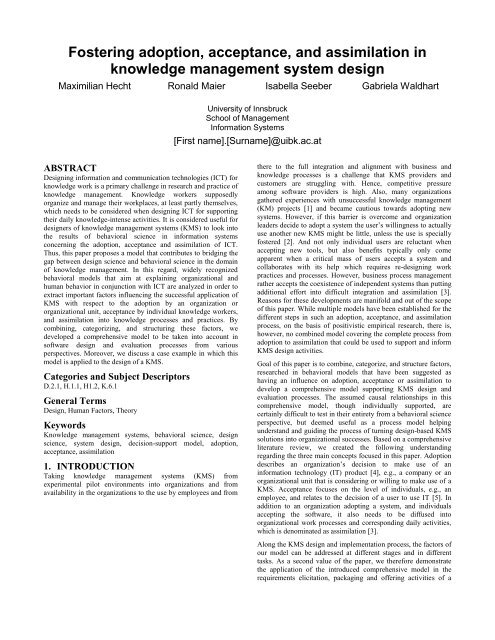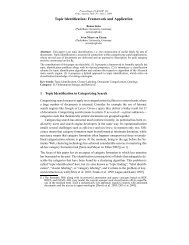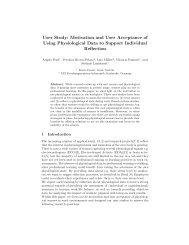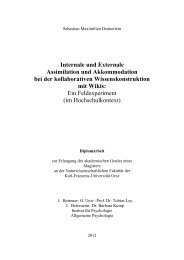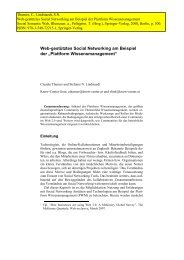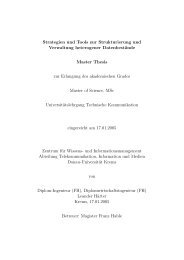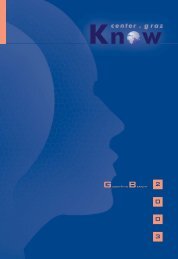Fostering adoption, acceptance and assimilation in ... - KnowMiner
Fostering adoption, acceptance and assimilation in ... - KnowMiner
Fostering adoption, acceptance and assimilation in ... - KnowMiner
Create successful ePaper yourself
Turn your PDF publications into a flip-book with our unique Google optimized e-Paper software.
<strong>Foster<strong>in</strong>g</strong> <strong>adoption</strong>, <strong>acceptance</strong>, <strong>and</strong> <strong>assimilation</strong> <strong>in</strong><br />
knowledge management system design<br />
Maximilian Hecht Ronald Maier Isabella Seeber Gabriela Waldhart<br />
ABSTRACT<br />
Design<strong>in</strong>g <strong>in</strong>formation <strong>and</strong> communication technologies (ICT) for<br />
knowledge work is a primary challenge <strong>in</strong> research <strong>and</strong> practice of<br />
knowledge management. Knowledge workers supposedly<br />
organize <strong>and</strong> manage their workplaces, at least partly themselves,<br />
which needs to be considered when design<strong>in</strong>g ICT for support<strong>in</strong>g<br />
their daily knowledge-<strong>in</strong>tense activities. It is considered useful for<br />
designers of knowledge management systems (KMS) to look <strong>in</strong>to<br />
the results of behavioral science <strong>in</strong> <strong>in</strong>formation systems<br />
concern<strong>in</strong>g the <strong>adoption</strong>, <strong>acceptance</strong> <strong>and</strong> <strong>assimilation</strong> of ICT.<br />
Thus, this paper proposes a model that contributes to bridg<strong>in</strong>g the<br />
gap between design science <strong>and</strong> behavioral science <strong>in</strong> the doma<strong>in</strong><br />
of knowledge management. In this regard, widely recognized<br />
behavioral models that aim at expla<strong>in</strong><strong>in</strong>g organizational <strong>and</strong><br />
human behavior <strong>in</strong> conjunction with ICT are analyzed <strong>in</strong> order to<br />
extract important factors <strong>in</strong>fluenc<strong>in</strong>g the successful application of<br />
KMS with respect to the <strong>adoption</strong> by an organization or<br />
organizational unit, <strong>acceptance</strong> by <strong>in</strong>dividual knowledge workers,<br />
<strong>and</strong> <strong>assimilation</strong> <strong>in</strong>to knowledge processes <strong>and</strong> practices. By<br />
comb<strong>in</strong><strong>in</strong>g, categoriz<strong>in</strong>g, <strong>and</strong> structur<strong>in</strong>g these factors, we<br />
developed a comprehensive model to be taken <strong>in</strong>to account <strong>in</strong><br />
software design <strong>and</strong> evaluation processes from various<br />
perspectives. Moreover, we discuss a case example <strong>in</strong> which this<br />
model is applied to the design of a KMS.<br />
Categories <strong>and</strong> Subject Descriptors<br />
D.2.1, H.1.1, H1.2, K.6.1<br />
General Terms<br />
Design, Human Factors, Theory<br />
Keywords<br />
Knowledge management systems, behavioral science, design<br />
science, system design, decision-support model, <strong>adoption</strong>,<br />
<strong>acceptance</strong>, <strong>assimilation</strong><br />
1. INTRODUCTION<br />
Tak<strong>in</strong>g knowledge management systems (KMS) from<br />
experimental pilot environments <strong>in</strong>to organizations <strong>and</strong> from<br />
availability <strong>in</strong> the organizations to the use by employees <strong>and</strong> from<br />
University of Innsbruck<br />
School of Management<br />
Information Systems<br />
[First name].[Surname]@uibk.ac.at<br />
there to the full <strong>in</strong>tegration <strong>and</strong> alignment with bus<strong>in</strong>ess <strong>and</strong><br />
knowledge processes is a challenge that KMS providers <strong>and</strong><br />
customers are struggl<strong>in</strong>g with. Hence, competitive pressure<br />
among software providers is high. Also, many organizations<br />
gathered experiences with unsuccessful knowledge management<br />
(KM) projects [1] <strong>and</strong> became cautious towards adopt<strong>in</strong>g new<br />
systems. However, if this barrier is overcome <strong>and</strong> organization<br />
leaders decide to adopt a system the user’s will<strong>in</strong>gness to actually<br />
use another new KMS might be little, unless the use is specially<br />
fostered [2]. And not only <strong>in</strong>dividual users are reluctant when<br />
accept<strong>in</strong>g new tools, but also benefits typically only come<br />
apparent when a critical mass of users accepts a system <strong>and</strong><br />
collaborates with its help which requires re-design<strong>in</strong>g work<br />
practices <strong>and</strong> processes. However, bus<strong>in</strong>ess process management<br />
rather accepts the coexistence of <strong>in</strong>dependent systems than putt<strong>in</strong>g<br />
additional effort <strong>in</strong>to difficult <strong>in</strong>tegration <strong>and</strong> <strong>assimilation</strong> [3].<br />
Reasons for these developments are manifold <strong>and</strong> out of the scope<br />
of this paper. While multiple models have been established for the<br />
different steps <strong>in</strong> such an <strong>adoption</strong>, <strong>acceptance</strong>, <strong>and</strong> <strong>assimilation</strong><br />
process, on the basis of positivistic empirical research, there is,<br />
however, no comb<strong>in</strong>ed model cover<strong>in</strong>g the complete process from<br />
<strong>adoption</strong> to <strong>assimilation</strong> that could be used to support <strong>and</strong> <strong>in</strong>form<br />
KMS design activities.<br />
Goal of this paper is to comb<strong>in</strong>e, categorize, <strong>and</strong> structure factors,<br />
researched <strong>in</strong> behavioral models that have been suggested as<br />
hav<strong>in</strong>g an <strong>in</strong>fluence on <strong>adoption</strong>, <strong>acceptance</strong> or <strong>assimilation</strong> to<br />
develop a comprehensive model support<strong>in</strong>g KMS design <strong>and</strong><br />
evaluation processes. The assumed causal relationships <strong>in</strong> this<br />
comprehensive model, though <strong>in</strong>dividually supported, are<br />
certa<strong>in</strong>ly difficult to test <strong>in</strong> their entirety from a behavioral science<br />
perspective, but deemed useful as a process model help<strong>in</strong>g<br />
underst<strong>and</strong> <strong>and</strong> guid<strong>in</strong>g the process of turn<strong>in</strong>g design-based KMS<br />
solutions <strong>in</strong>to organizational successes. Based on a comprehensive<br />
literature review, we created the follow<strong>in</strong>g underst<strong>and</strong><strong>in</strong>g<br />
regard<strong>in</strong>g the three ma<strong>in</strong> concepts focused <strong>in</strong> this paper. Adoption<br />
describes an organization’s decision to make use of an<br />
<strong>in</strong>formation technology (IT) product [4], e.g., a company or an<br />
organizational unit that is consider<strong>in</strong>g or will<strong>in</strong>g to make use of a<br />
KMS. Acceptance focuses on the level of <strong>in</strong>dividuals, e.g., an<br />
employee, <strong>and</strong> relates to the decision of a user to use IT [5]. In<br />
addition to an organization adopt<strong>in</strong>g a system, <strong>and</strong> <strong>in</strong>dividuals<br />
accept<strong>in</strong>g the software, it also needs to be diffused <strong>in</strong>to<br />
organizational work processes <strong>and</strong> correspond<strong>in</strong>g daily activities,<br />
which is denom<strong>in</strong>ated as <strong>assimilation</strong> [3].<br />
Along the KMS design <strong>and</strong> implementation process, the factors of<br />
our model can be addressed at different stages <strong>and</strong> <strong>in</strong> different<br />
tasks. As a second value of the paper, we therefore demonstrate<br />
the application of the <strong>in</strong>troduced comprehensive model <strong>in</strong> the<br />
requirements elicitation, packag<strong>in</strong>g <strong>and</strong> offer<strong>in</strong>g activities of a
large-scale European project <strong>in</strong> the doma<strong>in</strong> of technologyenhanced<br />
learn<strong>in</strong>g.<br />
The paper starts out with an <strong>in</strong>troduction <strong>in</strong>to the models <strong>and</strong><br />
theories (section 2) underly<strong>in</strong>g our model before present<strong>in</strong>g all<br />
factors <strong>in</strong>fluenc<strong>in</strong>g <strong>adoption</strong>, <strong>acceptance</strong> <strong>and</strong> <strong>assimilation</strong><br />
extracted from the models <strong>and</strong> theories <strong>and</strong> form<strong>in</strong>g a new<br />
comprehensive model (section 3). Section 4 outl<strong>in</strong>es the<br />
application of this model <strong>in</strong> a KMS design process as well as<br />
related approaches found <strong>in</strong> literature, followed by possible<br />
limitations (section 5) of the model <strong>and</strong> a conclusion <strong>in</strong>clud<strong>in</strong>g an<br />
outlook on future research (section 6).<br />
2. EXPLAINING ORGANIZATIONAL AND<br />
HUMAN BEHAVIOR TOWARDS IT<br />
Numerous models <strong>and</strong> theories aim at expla<strong>in</strong><strong>in</strong>g organizational<br />
<strong>and</strong> human behavior <strong>in</strong> respect to us<strong>in</strong>g IT systems. Many of them<br />
are orig<strong>in</strong>ally rooted <strong>in</strong> behavioral science, sociology <strong>and</strong><br />
psychology [6]. However, many of them have been transferred<br />
<strong>in</strong>to an Information Systems (IS) context <strong>and</strong> have been applied <strong>in</strong><br />
IS studies. In order to get a comprehensive underst<strong>and</strong><strong>in</strong>g <strong>and</strong><br />
overview, we structure the factors <strong>in</strong>to <strong>adoption</strong>, <strong>acceptance</strong> <strong>and</strong><br />
<strong>assimilation</strong> <strong>and</strong> exam<strong>in</strong>e models <strong>and</strong> theories <strong>in</strong> these three<br />
doma<strong>in</strong>s.<br />
2.1 Adoption<br />
In the context of the organizational decision to adopt an IT system<br />
or an IT <strong>in</strong>novation such as a KMS, the research literature<br />
presents various models <strong>and</strong> theories. In the follow<strong>in</strong>g, the models<br />
<strong>and</strong> theories that are used <strong>in</strong> this paper are shortly described. For<br />
further <strong>in</strong>formation about a s<strong>in</strong>gle model or theory, please refer to<br />
the given literature.<br />
The Technology-Organization-Environment Framework (TOE)<br />
[7] expla<strong>in</strong>s the process by which a firm adopts <strong>and</strong> implements<br />
technological <strong>in</strong>novations, <strong>in</strong>fluenced by the technological<br />
context, the organizational context, <strong>and</strong> the environmental<br />
context. TOE has been widely applied <strong>in</strong> IS research, e.g., to<br />
expla<strong>in</strong> the <strong>adoption</strong> of open systems [8] or to <strong>in</strong>vestigate the<br />
<strong>adoption</strong> of electronic bus<strong>in</strong>esses by European firms [9].<br />
The Diffusion of Innovations (DOI) theory, based on sociological<br />
research [4], has been used s<strong>in</strong>ce the 1960s to study several<br />
<strong>in</strong>novations regard<strong>in</strong>g <strong>adoption</strong> <strong>and</strong> <strong>acceptance</strong> by both,<br />
<strong>in</strong>dividuals <strong>and</strong> organizations [7]. There have been various<br />
applications of DOI to evaluate <strong>adoption</strong> on the organizational<br />
level, e.g., <strong>in</strong> the context of IS process <strong>in</strong>novations [10] or <strong>in</strong> the<br />
context of f<strong>in</strong>ancial EDI [11].<br />
The IS Success Model (ISSM) [12] does not explicitly focus on<br />
organizational <strong>adoption</strong>, but rather presents a framework for<br />
conceptualiz<strong>in</strong>g <strong>and</strong> operationaliz<strong>in</strong>g IS success. However,<br />
organizations prepar<strong>in</strong>g for a decision about adopt<strong>in</strong>g a<br />
technology will consider whether <strong>and</strong> to what extent the<br />
<strong>in</strong>troduction of the technology will result <strong>in</strong> a positive impact on<br />
the organization <strong>and</strong> thus, some of the factors found <strong>in</strong>fluential for<br />
IS success with<strong>in</strong> a company are expected to directly relate to the<br />
<strong>adoption</strong> of an IS.<br />
F<strong>in</strong>ally, the Fit-Viability Model (FVM) [13] is based on the theory<br />
of task-technology-fit [14] enhanced with organizational viability.<br />
In a first application, it was used to exam<strong>in</strong>e the <strong>adoption</strong> of<br />
mobile technology <strong>in</strong> bus<strong>in</strong>esses [13].<br />
2.2 Acceptance<br />
Various models <strong>and</strong> theories exist that seek to expla<strong>in</strong> a user’s<br />
decision to make use of an ICT system. Those that are deemed<br />
relevant for <strong>acceptance</strong> are listed <strong>in</strong> the follow<strong>in</strong>g.<br />
The Theory of Reasoned Action (TRA) [15], was drawn from<br />
social psychology <strong>and</strong> is one of the most fundamental <strong>and</strong><br />
<strong>in</strong>fluential theories of human behavior <strong>in</strong> IS research. TRA<br />
theorizes that the behavior of an <strong>in</strong>dividual can be predicted based<br />
on the person’s behavioral <strong>in</strong>tention. In other words, if a person<br />
<strong>in</strong>tends to behave <strong>in</strong> a certa<strong>in</strong> way then he or she is likely to do so,<br />
based on one’s attitude <strong>and</strong> the <strong>in</strong>fluence of other people’s<br />
op<strong>in</strong>ions (subjective norm). TRA was applied to expla<strong>in</strong> the<br />
<strong>acceptance</strong> of technology by users <strong>and</strong> found that their results<br />
were consistent with TRA applications <strong>in</strong> other research fields<br />
[16].<br />
The Theory of Planned Behavior (TPB) [17] extends TRA with<br />
the construct of perceived behavioral control as an additional<br />
determ<strong>in</strong>ant of behavioral <strong>in</strong>tention that takes one's perception of<br />
the difficulty of perform<strong>in</strong>g a behavior <strong>in</strong>to account. It has been<br />
successfully applied to expla<strong>in</strong> <strong>in</strong>dividual <strong>acceptance</strong> <strong>and</strong> usage of<br />
various technologies [8,18].<br />
Furthermore, the Technology Acceptance Model (TAM) is an<br />
adaptation of TRA tailored to the field of IS to predict <strong>in</strong>formation<br />
technology <strong>acceptance</strong> <strong>and</strong> usage on the job [16] <strong>and</strong> has been<br />
widely applied to various technologies <strong>and</strong> user groups [6]. An<br />
extended version of TAM is TAM 2 which <strong>in</strong>cludes subjective<br />
norm as an additional factor to predict <strong>in</strong>tention <strong>in</strong> the case of<br />
m<strong>and</strong>atory sett<strong>in</strong>gs [19].<br />
As already <strong>in</strong>troduced above, the Diffusion of Innovations (DOI)<br />
theory has been used to study several <strong>in</strong>novations regard<strong>in</strong>g<br />
<strong>adoption</strong> <strong>and</strong> <strong>acceptance</strong> by both, <strong>in</strong>dividuals <strong>and</strong> organizations<br />
[20]. Consequently, it can also be used <strong>in</strong> the context of<br />
<strong>acceptance</strong> as conceptualized here. For this purpose, DOI was<br />
transferred <strong>in</strong>to an IS context <strong>and</strong> ref<strong>in</strong>ed to study <strong>in</strong>dividual<br />
technology <strong>acceptance</strong> [19].<br />
The Motivational Model (MM) has a different focus than the ones<br />
mentioned above [21]. It was <strong>in</strong>fluenced by research <strong>in</strong><br />
psychology <strong>and</strong> represents an application of motivational theory<br />
to underst<strong>and</strong> new technology <strong>acceptance</strong> <strong>and</strong> use [21,22].<br />
Consequently, it focuses on motivational constructs, i.e., <strong>in</strong>tr<strong>in</strong>sic<br />
<strong>and</strong> extr<strong>in</strong>sic motivation, <strong>in</strong> order to expla<strong>in</strong> <strong>and</strong> predict user<br />
<strong>acceptance</strong>.<br />
The Model of Personal Computer Utilization (MPCU) [23] is<br />
based on the theory of human behavior. It was orig<strong>in</strong>ally<br />
<strong>in</strong>troduced to predict the way of usage rather than the decision to<br />
use it or not. However, it comprises factors that are deemed<br />
suitable to predict <strong>in</strong>dividual <strong>acceptance</strong> as well [6].<br />
A model that is helpful for both, predict<strong>in</strong>g <strong>in</strong>dividual <strong>and</strong> group<br />
behavior is the Social Cognitive Theory (SCT) [24] which<br />
identifies human behavior as an <strong>in</strong>teraction of personal factors,<br />
behavior, <strong>and</strong> the environment. An application <strong>in</strong> the field of KM<br />
is given with<strong>in</strong> a study on us<strong>in</strong>g a laissez-faire approach for<br />
improv<strong>in</strong>g knowledge work methods that traditionally have<br />
employed a top-down approach [25].<br />
The Unified Theory of Acceptance <strong>and</strong> Use of Technology<br />
(UTAUT) [6] groups the most important constructs of all<br />
<strong>acceptance</strong> models named above describ<strong>in</strong>g behavioral <strong>in</strong>tention<br />
<strong>and</strong> usage behavior with these groups, <strong>in</strong>fluenced by so-called<br />
moderators, e.g., the user’s age <strong>and</strong> gender [6]. However, all<br />
factors taken <strong>in</strong>to account <strong>in</strong> this model are mentioned <strong>in</strong> at least
one of the models before. Therefore, there were no additional<br />
factors collected directly from the UTAUT model.<br />
2.3 Assimilation<br />
The follow<strong>in</strong>g models aim at expla<strong>in</strong><strong>in</strong>g the <strong>assimilation</strong> of a new<br />
technology by collectives of users <strong>in</strong>to their work processes <strong>and</strong><br />
practices.<br />
Institution Theory (INST) states that organizations’ <strong>and</strong><br />
<strong>in</strong>dividuals’ choices <strong>and</strong> behavior are <strong>in</strong>fluenced by social<br />
structures embedded <strong>in</strong> the environment. In this regard, three<br />
general differentiations compris<strong>in</strong>g regulative, normative, <strong>and</strong><br />
cognitive elements can be made. Regulative elements refer to the<br />
avoidance of violations aga<strong>in</strong>st laws <strong>and</strong> regulations by<br />
<strong>in</strong>dividuals to avoid organizational sanctions aga<strong>in</strong>st themselves.<br />
Normative elements are understood as embedd<strong>in</strong>g social<br />
underst<strong>and</strong><strong>in</strong>g <strong>in</strong>to decision-mak<strong>in</strong>g rules or procedures on an<br />
organizational level. Cognitive elements on an organizational<br />
level describe social structures that constitute the nature of reality<br />
<strong>and</strong> development of mean<strong>in</strong>g. Individual behavior <strong>in</strong> such cases is<br />
<strong>in</strong>formed by cognitive guidance that allow them underst<strong>and</strong><strong>in</strong>g<br />
how they should behave [3,26].<br />
Structuration Theory (ST) is a frequently used theory <strong>in</strong> IS<br />
research [27] <strong>and</strong> is the basis for Adaptive Structuration Theory<br />
(AST). These theories are appeal<strong>in</strong>g to IS research, s<strong>in</strong>ce they<br />
focus on social aspects of IS, <strong>in</strong> particular they analyze structure<br />
<strong>and</strong> the processes by which structures are used <strong>and</strong> modified over<br />
time [28]. The theories comprise a number of concepts that help to<br />
underst<strong>and</strong> how users <strong>in</strong>terpret IS <strong>and</strong> how they actually use them<br />
compared to the <strong>in</strong>tended usage by designers <strong>and</strong> developers,<br />
called appropriation. This is an <strong>in</strong>herently social process relat<strong>in</strong>g<br />
to the collective behavior of the group of users <strong>and</strong> stakeholders<br />
affected by a new system. It expla<strong>in</strong>s how organizational<br />
structures <strong>and</strong> rout<strong>in</strong>es are impacted by the use of IS on the one<br />
h<strong>and</strong> <strong>and</strong> how IS are <strong>in</strong>terpreted from the perspective of the<br />
organizational structures <strong>and</strong> rout<strong>in</strong>es on the other h<strong>and</strong> [29].<br />
An <strong>in</strong>terpretation of the DOI theory emphasizes the role of<br />
knowledge <strong>and</strong> organizational learn<strong>in</strong>g as potential barriers to<br />
successful rollout of <strong>in</strong>novations <strong>and</strong> provides a<br />
reconceptualization of the diffusion theory for complex<br />
organizational technologies [30]. These complex technologies<br />
create a knowledge barrier to the users that <strong>in</strong>hibits diffusion.<br />
Therefore, technology suppliers should actively encourage<br />
diffusion by develop<strong>in</strong>g procedures that lower knowledge barriers<br />
<strong>in</strong> order to improve the <strong>assimilation</strong> [31]. Hence, DOI is also<br />
useful for expla<strong>in</strong><strong>in</strong>g <strong>assimilation</strong> of IT <strong>in</strong>to processes <strong>and</strong><br />
practices, e.g., it was applied to exam<strong>in</strong>e the <strong>assimilation</strong> of<br />
collaborative <strong>in</strong>formation technologies [32].<br />
The Knowledge-based Theory of the firm (KBT) considers<br />
knowledge as a resource that has strategic significance for<br />
organizations. Potential competitive advantage <strong>and</strong> susta<strong>in</strong>ability<br />
can be achieved due to the fact that knowledge compris<strong>in</strong>g<br />
policies, rout<strong>in</strong>es, or employees is difficult to imitate <strong>and</strong> socially<br />
complex <strong>in</strong> the sense that it is embedded <strong>in</strong> the social fabric of<br />
collectives of people which cannot easily be transferred [33, 34].<br />
Besides the models <strong>and</strong> theories above, we looked <strong>in</strong>to<br />
characteristics of (bus<strong>in</strong>ess) processes <strong>in</strong> order to help decision<br />
makers judge whether changes consider<strong>in</strong>g work processes <strong>and</strong><br />
practices have improved organizational performance. Bus<strong>in</strong>ess<br />
process management (BPM) [35] has also been extended to cover<br />
processes of knowledge work [36]. As <strong>assimilation</strong> refers to the<br />
actual use of the adopted technology with<strong>in</strong> processes, it seems<br />
useful to consider the follow<strong>in</strong>g factors that correspond to<br />
qualitative <strong>and</strong> quantitative process goals: process quality<br />
(qualitative <strong>and</strong> quantitative process goals), process costs<br />
(quantitative process goals), <strong>and</strong> process time (temporal process<br />
goals) <strong>and</strong> customer process satisfaction (process-external view of<br />
quality) [37,38].<br />
3. METHOD<br />
The models presented above give valuable <strong>in</strong>sights <strong>in</strong>to <strong>adoption</strong>,<br />
<strong>acceptance</strong> or <strong>assimilation</strong> from different po<strong>in</strong>ts of view with<br />
different focuses <strong>and</strong> partly overlapp<strong>in</strong>g concepts. However, <strong>in</strong><br />
order to consider <strong>and</strong> improve these topics with<strong>in</strong> the design of a<br />
KMS, a more comprehensive <strong>and</strong> consolidated model is needed<br />
that gives an overview of factors <strong>in</strong>fluenc<strong>in</strong>g the <strong>adoption</strong>,<br />
<strong>acceptance</strong> <strong>and</strong> <strong>assimilation</strong> of KMS, thus reduc<strong>in</strong>g complexity<br />
<strong>and</strong> present<strong>in</strong>g the models <strong>and</strong> theories <strong>in</strong> a form that is more<br />
easily underst<strong>and</strong>able <strong>and</strong> applicable for decision makers<br />
responsible for design, development <strong>and</strong> implementation of KMS.<br />
Additionally, it would be helpful to dist<strong>in</strong>guish between factors<br />
that can be <strong>in</strong>fluenced by KMS design <strong>and</strong> factors that cannot.<br />
Therefore, we comb<strong>in</strong>ed the models <strong>and</strong> theories named above<br />
expla<strong>in</strong><strong>in</strong>g behavior of <strong>in</strong>dividuals <strong>and</strong> organizations us<strong>in</strong>g IT<br />
with the aim to use the result<strong>in</strong>g model as guidance for KMS<br />
design purposes. For each of the three topics, i.e. <strong>adoption</strong>,<br />
<strong>acceptance</strong> <strong>and</strong> <strong>assimilation</strong>, we collected highly cited models<br />
which we analyzed sequentially, extract<strong>in</strong>g <strong>in</strong>fluenc<strong>in</strong>g factors<br />
given <strong>in</strong> the model or theory. In do<strong>in</strong>g so, we got three sets of<br />
factors that <strong>in</strong>fluence <strong>adoption</strong>, <strong>acceptance</strong> or <strong>assimilation</strong><br />
respectively <strong>and</strong> orig<strong>in</strong>ate <strong>in</strong> one or more of the models <strong>and</strong><br />
theories discussed <strong>in</strong> Section 2. In order to improve<br />
underst<strong>and</strong>ability <strong>and</strong> reusability of the 81 collected factors, we<br />
further categorized them thematically <strong>in</strong>to 17 factor groups. Thus,<br />
we provide a structured basis for subsequent work with our<br />
comprehensive model. The factors are listed <strong>in</strong> tables <strong>in</strong> the<br />
follow<strong>in</strong>g three subsections. A def<strong>in</strong>ition of the s<strong>in</strong>gle factors can<br />
be found <strong>in</strong> the literature given for the respective model or theory.<br />
The factors need to be operationalized accord<strong>in</strong>g to the specific<br />
context of a situation of an organization will<strong>in</strong>g to adopt a KMS,<br />
e.g., characteristics of the bus<strong>in</strong>ess sector to be addressed by the<br />
KMS. An example for the <strong>in</strong>terpretation of factors with<strong>in</strong> a special<br />
context is given as part of Section 4.<br />
In a last step, we analyzed the factor groups <strong>in</strong> respect to whether<br />
they can be <strong>in</strong>fluenced with<strong>in</strong> the design or not, i.e. if the factors<br />
with<strong>in</strong> one group can be <strong>in</strong>fluenced by design decisions. In the<br />
follow<strong>in</strong>g, these steps are presented <strong>in</strong> more detail <strong>in</strong> the<br />
respective subsections.<br />
3.1 Adoption Factors<br />
We collected 37 factors <strong>in</strong>fluenc<strong>in</strong>g the organizations’ decision on<br />
adopt<strong>in</strong>g a KMS which are presented together with their<br />
orig<strong>in</strong>at<strong>in</strong>g model or theory <strong>in</strong> table 1.<br />
Furthermore, we categorized the factors <strong>in</strong>fluenc<strong>in</strong>g the <strong>adoption</strong><br />
<strong>in</strong>to eight groups depend<strong>in</strong>g on the thematic orig<strong>in</strong> of the factors.<br />
The Environment group comb<strong>in</strong>es factors external to the adopt<strong>in</strong>g<br />
organization; the Innovation Characteristics groups collects<br />
factors that are def<strong>in</strong>ed only by the KMS product itself <strong>and</strong> the<br />
type of <strong>in</strong>novation it represents; Fit comb<strong>in</strong>es factors related to the<br />
suitability of the KMS solution to the tasks it is <strong>in</strong>tended to<br />
support <strong>and</strong> the <strong>in</strong>frastructure it is <strong>in</strong>tended to be applied <strong>in</strong><br />
<strong>in</strong>fluenced by the solution itself as well as the organization;<br />
Expected Results comb<strong>in</strong>es factors related to the perceived quality<br />
<strong>and</strong> impact of the KMS’s <strong>adoption</strong>; the factors with<strong>in</strong> the group<br />
Organizational Characteristics correspond to general properties<br />
of the adopt<strong>in</strong>g organization, while the groups Communication
Characteristics, Technological Infrastructure <strong>and</strong> Resources<br />
comb<strong>in</strong>e factors that are related to particular organizational<br />
properties <strong>in</strong> the context of its communication processes <strong>and</strong><br />
practices, the technology already <strong>in</strong> place with which the KMS<br />
needs to be connected <strong>and</strong> monetary <strong>and</strong> human resources related<br />
to the <strong>adoption</strong> of the KMS. The groups are graphically presented<br />
with<strong>in</strong> the f<strong>in</strong>al model <strong>in</strong> figure 1.<br />
Table 1: List of Factors for Organizational Adoption<br />
Factor name Model/Theory<br />
Adopter type DOI<br />
Availability TOE<br />
Characteristics TOE<br />
Commercial Advantage DOI<br />
Communication Process TOE<br />
Community Norms DOI<br />
Compatibility DOI<br />
Complexity DOI<br />
Cultural Values DOI<br />
Formal <strong>and</strong> Informal L<strong>in</strong>k<strong>in</strong>g Structures TOE<br />
Fund<strong>in</strong>g DOI<br />
Government Regulations TOE<br />
Industry Characteristics <strong>and</strong> Market Structure TOE<br />
Informal Communication DOI<br />
Information Quality ISSM<br />
Management Hierarchy DOI<br />
Observability DOI<br />
Op<strong>in</strong>ion Leaders <strong>and</strong> Change Agents DOI<br />
Organizational Impact ISSM<br />
Organizational Viability FVM<br />
Price DOI<br />
Problem Solver DOI<br />
Relative Advantage DOI<br />
Risk DOI<br />
Size TOE<br />
Service Quality ISSM<br />
Slack Resources TOE<br />
St<strong>and</strong>ard DOI<br />
System Quality ISSM<br />
Task-Technology Fit FVM<br />
Technological Edge DOI<br />
Technological Experience DOI<br />
Technological Infrastructure DOI<br />
Technology Support Infrastructure TOE<br />
Trialability DOI<br />
User Need Recognition DOI<br />
User Resistance DOI<br />
The factors with<strong>in</strong> the groups Environment, Organizational<br />
Characteristics, Technological Infrastructure <strong>and</strong> Resources<br />
cannot be directly <strong>in</strong>fluenced by KMS design, as they are<br />
organization specific path-dependent idiosyncrasies or externally<br />
determ<strong>in</strong>ed. In contrast, the factors categorized <strong>in</strong> Innovation<br />
Characteristics, Communication Characteristics <strong>and</strong> Expected<br />
Results are affected by decisions related to the KMS design, as<br />
many of them correspond to qualities <strong>and</strong> features of the KMS<br />
product. Fit is a mapp<strong>in</strong>g between KMS <strong>and</strong> the selected tasks <strong>and</strong><br />
environment it should support <strong>and</strong> thus supposedly can also be<br />
<strong>in</strong>fluenced by KMS design.<br />
3.2 Acceptance Factors<br />
We identified 22 factors expla<strong>in</strong><strong>in</strong>g the <strong>acceptance</strong> of KMS by<br />
users as listed <strong>in</strong> table 2. The factors <strong>in</strong>fluenc<strong>in</strong>g the <strong>acceptance</strong><br />
have been categorized <strong>in</strong>to four groups. Two groups comb<strong>in</strong>e all<br />
expectancy-related factors: Effort Expectancy collects factors<br />
related to users’ perceptions of what they need to contribute to<br />
work with the KMS (<strong>in</strong>put) <strong>and</strong> Performance Expectancy collects<br />
factors related to users’ perceptions of what the impact of work<strong>in</strong>g<br />
with the KMS will be (output). The factors <strong>in</strong> the third group are<br />
moderat<strong>in</strong>g factors from the social environment of a user (Social<br />
Influences) <strong>and</strong> the factors <strong>in</strong> the last group are personal factors<br />
impact<strong>in</strong>g the <strong>acceptance</strong> decision (Attitude towards Technology-<br />
Use).<br />
Consequently, factors with<strong>in</strong> the groups Attitude towards Us<strong>in</strong>g<br />
Technology <strong>and</strong> Social Influence are depend<strong>in</strong>g on culture,<br />
organizational peculiarities <strong>and</strong> personal preferences <strong>and</strong> thus<br />
cannot be directly <strong>in</strong>fluenced by design. The factor groups<br />
Performance Expectancy <strong>and</strong> Effort Expectancy are also<br />
underly<strong>in</strong>g subjective <strong>in</strong>fluences, however, these factor can be<br />
<strong>in</strong>fluenced by KMS design, e.g., by ensur<strong>in</strong>g high quality<br />
st<strong>and</strong>ards <strong>and</strong> provid<strong>in</strong>g useful product features.<br />
Table 2: List of Factors for User Acceptance<br />
Factor name Model/Theory<br />
Affect Towards Use SCT; MPCU<br />
Anxiety SCT<br />
Attitude Toward Behavior TRA; TPB<br />
Compatibility DOI<br />
Complexity MPCU<br />
Ease of Use DOI; TAM; TAM2<br />
Extr<strong>in</strong>sic Motivation MM<br />
Facilitat<strong>in</strong>g Conditions MPCU<br />
Image DOI<br />
Intr<strong>in</strong>sic Motivation MM<br />
Job-Fit MPCU<br />
Long-term Consequences MPCU<br />
Outcome Expectations - Performance SCT<br />
Outcome Expectations - Personal SCT<br />
Perceived Behavioral Control TPB<br />
Usefulness TAM; TAM2<br />
Relative Advantage DOI<br />
Results Demonstrability DOI<br />
Self-efficacy SCT<br />
Social Factors MPCU<br />
Subjective Norm TRA; TAM2; TPB<br />
Visibility DOI<br />
3.3 Assimilation Factors<br />
Lastly, table 3 presents 22 factors that <strong>in</strong>fluence the <strong>assimilation</strong><br />
of a KMS. The collected factors were categorized <strong>in</strong>to four<br />
groups: Institutional Characteristics, comb<strong>in</strong><strong>in</strong>g factors related to<br />
certa<strong>in</strong> characteristics of the organization adopt<strong>in</strong>g the KMS,<br />
Social System Characteristics comb<strong>in</strong><strong>in</strong>g factors describ<strong>in</strong>g social<br />
structures, as well as communication <strong>and</strong> collaboration<br />
peculiarities of the organization, Process Characteristics,<br />
comb<strong>in</strong><strong>in</strong>g factors describ<strong>in</strong>g processes <strong>in</strong> terms of a set of<br />
st<strong>and</strong>ard process goals; <strong>and</strong> lastly Management Characteristics,<br />
which <strong>in</strong>clude factors related to management quality, support <strong>and</strong><br />
selected practices deemed important for the success of KMS<br />
<strong>assimilation</strong> <strong>in</strong>to the organization.
In consideration of the fact that <strong>assimilation</strong> as a third step refers<br />
to the diffusion of a solution <strong>in</strong>to organizational processes <strong>and</strong><br />
work practices, nearly all of the factors correspond to<br />
organization-specific peculiarities. However, when look<strong>in</strong>g at the<br />
factors that are highly affected by a new KMS, we expect Process<br />
Characteristics <strong>and</strong> Social System Characteristics to change<br />
depend<strong>in</strong>g on the design of the <strong>in</strong>troduced KMS. Consequently,<br />
the factors with<strong>in</strong> these two groups can be <strong>in</strong>directly <strong>in</strong>fluenced by<br />
design decisions. In contrast, the <strong>in</strong>troduction of a KMS will<br />
probably have less impact on Management Characteristics or<br />
Institutional Characteristics.<br />
Table 3: List of Factors for Process Assimilation<br />
Factor name Model/Theory<br />
Communication Channels Use DOI<br />
Decision-mak<strong>in</strong>g Patterns DOI<br />
Extent of Coord<strong>in</strong>ation INST<br />
Functional Integration DOI<br />
Knowledge Barrier DOI<br />
Knowledge Embeddedness DOI<br />
Management Championship INST<br />
Methodology Influence INST<br />
Organizational Size KBT<br />
IT Function Size DOI; INST<br />
Process Cost BPM<br />
Process Quality BPM<br />
Process Time BPM<br />
Process Satisfaction BPM<br />
Promotion of Collaboration DOI<br />
Quality of Senior Leadership KBT<br />
Sophistication of IT Infrastructures KBT<br />
Strategic Investment Rationale INST<br />
Structures of Significance ST; INST (cognitive)<br />
Structures of Dom<strong>in</strong>ation ST; INST (regulatory)<br />
Structures of Legitimation ST; INST (normative)<br />
Top Management Championship ST<br />
3.4 Result<strong>in</strong>g Model<br />
Figure 1 presents the comprehensive model that comb<strong>in</strong>es factors<br />
impact<strong>in</strong>g on the process of <strong>adoption</strong>, <strong>acceptance</strong> <strong>and</strong> <strong>assimilation</strong><br />
of KMS. Moreover, the factors have been categorized so that<br />
guidance can be offered on two levels of granularity, namely the<br />
level of groups of factors <strong>and</strong> the level of <strong>in</strong>dividual factors.<br />
Furthermore, the model visually separates the groups that can be<br />
<strong>in</strong>fluenced with<strong>in</strong> the design phase from groups that cannot be<br />
<strong>in</strong>fluenced as argued above.<br />
This differentiation seems useful because designers of KMS can<br />
dist<strong>in</strong>guish between factors that can be <strong>in</strong>fluenced <strong>and</strong> thus are<br />
important when elicit<strong>in</strong>g functional <strong>and</strong> non-functional<br />
requirements while others can be considered as environmental<br />
limitations which need to be taken <strong>in</strong>to account particularly when<br />
packag<strong>in</strong>g a KMS <strong>and</strong> offer<strong>in</strong>g it to various target groups. The set<br />
of groups that cannot be <strong>in</strong>fluenced by design partially consists of<br />
environmental characteristics which cannot be directly<br />
manipulated, neither by providers of KMS nor by organizations<br />
us<strong>in</strong>g them. Other factors that cannot be <strong>in</strong>fluenced correspond to<br />
characteristics of an organization <strong>and</strong> <strong>in</strong>dividuals will<strong>in</strong>g to adopt<br />
a new technology that are comparably stable over time. However,<br />
some factors <strong>in</strong> this set of groups can be changed when us<strong>in</strong>g a<br />
KMS. Examples are Social Systems Characteristics which are<br />
<strong>in</strong>fluenced by IT <strong>and</strong> also <strong>in</strong>fluence how IT is used. Accord<strong>in</strong>g to<br />
AST, designers should particularly be aware of these<br />
characteristics <strong>and</strong> should explicitly state the <strong>in</strong>tended use of the<br />
KMS which, however, needs to be dist<strong>in</strong>guished from the KMS’s<br />
actual use <strong>in</strong> a particular organization.<br />
4. RELATED WORK & APPLICATION<br />
Thus far, we have presented a comprehensive model of factors<br />
relevant for KMS design impact<strong>in</strong>g the <strong>adoption</strong>, <strong>acceptance</strong>, <strong>and</strong><br />
<strong>assimilation</strong> of IT. The model <strong>in</strong>tends to provide guidance for<br />
analyz<strong>in</strong>g <strong>and</strong> reflect<strong>in</strong>g decisions related to KMS design,<br />
development <strong>and</strong> implementation <strong>in</strong> organizations based on the<br />
collected factor groups <strong>and</strong> their factors for each phase <strong>in</strong> the<br />
context of an ongo<strong>in</strong>g software project. This manner of <strong>in</strong>form<strong>in</strong>g<br />
software design, compris<strong>in</strong>g for example phases such as<br />
requirements elicitation, configuration, packag<strong>in</strong>g, <strong>and</strong> offer<strong>in</strong>g, is<br />
not yet widely observable <strong>in</strong> the doma<strong>in</strong> of KM. However, some<br />
comparable work <strong>in</strong> the general doma<strong>in</strong> of IS research can be<br />
named.<br />
In ongo<strong>in</strong>g research, an evaluation model for Question Answer<strong>in</strong>g<br />
Systems has been developed that focuses on user-centered<br />
evaluation rather than on system-centered evaluation. The<br />
proposed model comprises constructs taken from behavioral<br />
science models, such as TAM, UTAUT, TRA, <strong>and</strong> TPB, to<br />
<strong>in</strong>crease user <strong>acceptance</strong> when design<strong>in</strong>g Question Answer<strong>in</strong>g<br />
Systems [39,40]. Another study focuses on Employee<br />
Relationship Management systems <strong>and</strong> <strong>in</strong>vestigates the impact of<br />
usefulness on systems quality perceptions. Specific user needs<br />
should be considered <strong>in</strong> the analysis phase of system design <strong>and</strong><br />
therefore need to be assessed properly. The model draws upon<br />
TAM among others to expla<strong>in</strong> perceived usefulness [41]. It is<br />
rather common to use research results amalgamated <strong>in</strong>to a s<strong>in</strong>gle<br />
model for predict<strong>in</strong>g behavior to <strong>in</strong>form system design. For<br />
example, a study used TAM to measure perceived usefulness<br />
when analyz<strong>in</strong>g the connection between website design <strong>and</strong><br />
impulse buy<strong>in</strong>g <strong>in</strong> the doma<strong>in</strong> of e-commerce. Subsequently,<br />
research results were used to give concrete recommendations for<br />
e-commerce website designers [42].<br />
In the application of our model we followed a similar approach. In<br />
context of a large-scale research <strong>and</strong> development project, we<br />
applied the proposed model for <strong>in</strong>form<strong>in</strong>g <strong>and</strong> extend<strong>in</strong>g<br />
requirements elicitation (especially for non-functional<br />
requirements), as well as support<strong>in</strong>g decisions with respect to<br />
packag<strong>in</strong>g <strong>and</strong> offer<strong>in</strong>g of the KMS implemented <strong>in</strong> this project.<br />
The project aims at design<strong>in</strong>g an ICT solution support<strong>in</strong>g <strong>and</strong><br />
enhanc<strong>in</strong>g employees <strong>in</strong> their daily activities related to Human<br />
Resource Management, Bus<strong>in</strong>ess Process Management, KM <strong>and</strong><br />
Innovation Management. In our efforts to <strong>in</strong>crease <strong>adoption</strong>,<br />
<strong>acceptance</strong>, <strong>and</strong> <strong>assimilation</strong> of this KMS, 77 recommendations<br />
were developed for the design of the platform <strong>and</strong> addressed to<br />
platform architects, designers <strong>and</strong> developers of related bus<strong>in</strong>ess<br />
plans. These recommendations were developed by evaluat<strong>in</strong>g so<br />
far def<strong>in</strong>ed requirements, technological trends, <strong>and</strong> the ICT<br />
l<strong>and</strong>scapes of pilot organizations <strong>in</strong> respect to our model.<br />
The rema<strong>in</strong>der of this section will exemplify the use of the<br />
presented model to describe a collection of additional<br />
requirements <strong>and</strong> recommendations <strong>in</strong> two application areas.<br />
Here, application areas describe project-specific work groups that<br />
work on requirements elicitation, packag<strong>in</strong>g <strong>and</strong> offer<strong>in</strong>g solutions<br />
for the KMS.
Innovation Characteristics<br />
· Availability<br />
· Characteristics<br />
· Complexity<br />
· Price<br />
· Relative Advantage<br />
· St<strong>and</strong>ard<br />
· Technological Edge<br />
· Trialability<br />
Fit<br />
· Compatibility<br />
· Task-Technology Fit<br />
· User Need Recognition<br />
Expected Results<br />
· Commercial Advantage<br />
· Information Quality<br />
· Organizational Impact<br />
· Problem Solver<br />
· Risk<br />
· Service Quality<br />
· System Quality<br />
· Observability<br />
· Communication Process<br />
· Community Norms<br />
· Informal Communication<br />
Can be<br />
<strong>in</strong>fluenced by<br />
design<br />
Cannot be<br />
<strong>in</strong>fluenced by<br />
design<br />
Communication Characteristics<br />
Environment<br />
· Government Regulation<br />
· Industry Characteristics <strong>and</strong> Market<br />
Structure<br />
Technological Infrastructure<br />
· Technological Infrastructure<br />
· Technology Support Infrastructure<br />
Resources<br />
· Fund<strong>in</strong>g<br />
· Slack Resources<br />
Organizational Characteristics<br />
· Adopter Type<br />
· Cultural Values<br />
· Formal <strong>and</strong> Informal L<strong>in</strong>k<strong>in</strong>g Structures<br />
· Management Hierarchy<br />
· Organizational Viability<br />
· Size<br />
· Technological Experience<br />
· User Resistance<br />
· Op<strong>in</strong>ion Leaders <strong>and</strong> Change Agents<br />
Effort Expectancy<br />
· Complexity<br />
· Ease of Use<br />
· Facilitat<strong>in</strong>g Conditions<br />
Performance Expectancy<br />
· Job-Fit<br />
· Long-term Consequences<br />
· Outcome Expectations – Performance<br />
· Outcome Expectations – Personal<br />
· Usefulness<br />
· Relative Advantage<br />
· Results Demonstrability<br />
· Compatibility<br />
Social System Characteristics<br />
· Communication Channels Use<br />
· Extent of Coord<strong>in</strong>ation<br />
· Knowledge Barrier<br />
· Structures of Significance<br />
· Structures of Dom<strong>in</strong>ation<br />
· Structures of Legitimation<br />
Process Characteristics<br />
· Process Cost<br />
· Process Quality<br />
· Process Time<br />
· Process Satisfaction<br />
Adoption Acceptance<br />
Assimilation<br />
XOR<br />
Social Influences<br />
· Image<br />
· Social Factors<br />
· Subjective Norm<br />
· Visibility<br />
· Extr<strong>in</strong>sic Motivation<br />
Attitude towards Technology-Use<br />
· Affect Towards Use<br />
· Anxiety<br />
· Attitude Toward Behavior<br />
· Perceived Behavioral Control<br />
· Intr<strong>in</strong>sic Motivation<br />
· Self-efficacy<br />
Management Characteristics<br />
· Decision-mak<strong>in</strong>g Patterns<br />
· Management Championship<br />
· Methodology Influence<br />
· Promotion of Collaboration<br />
· Quality of Senior Leadership<br />
· Top Management Championship<br />
Institutional Characteristics<br />
· Functional Integration<br />
· Knowledge Embeddedness<br />
· Organizational Size<br />
· IT Function Size<br />
· Sophistication of IT Infrastructure<br />
· Strategic Investment Rationale<br />
Figure 1: Model of Factors <strong>in</strong>fluenc<strong>in</strong>g the Adoption, Acceptance <strong>and</strong> Assimilation <strong>in</strong> KMS Design<br />
Requirements Elicitation. With<strong>in</strong> this application area, system<br />
designers developed user requirements for the KMS, compris<strong>in</strong>g<br />
functional <strong>and</strong> non-functional requirements. To support <strong>adoption</strong><br />
by organizations, a recommendation was based on the factors<br />
Task-Technology Fit <strong>and</strong> User-Need Recognition <strong>in</strong> the factor<br />
group Fit. Task-Technology fit is understood as the degree to<br />
which the requirements of the tasks that should be supported by<br />
the new technology <strong>and</strong> the nature of the new technology match<br />
[13]. User-Need Recognition describes the degree to which an<br />
<strong>in</strong>novation matches the user needs <strong>in</strong> the tasks [10]. In this<br />
context, the architecture team was advised that the f<strong>in</strong>al<br />
architecture should allow for high configurability of the user<br />
<strong>in</strong>terface (UI) <strong>and</strong> provided services. Personalized services, which<br />
<strong>in</strong> turn draw upon exist<strong>in</strong>g system functionality, can be composed<br />
<strong>and</strong> further customized <strong>in</strong> order to adapt to a user’s context <strong>and</strong><br />
needs. Users hold various needs, which can be met by provid<strong>in</strong>g<br />
configurable software to <strong>in</strong>crease successful <strong>acceptance</strong> of KMS.<br />
The factor Complexity <strong>in</strong> the Effort Expectancy group describes<br />
the perception of the user to which degree it is difficult to<br />
underst<strong>and</strong> <strong>and</strong> use the new technology [23] while Ease of Use<br />
expla<strong>in</strong>s the degree to which a new technology is perceived as<br />
be<strong>in</strong>g difficult to use [6]. Hence, additional functionalities to<br />
provide a number of exemplary configuration for different user<br />
needs <strong>in</strong> order to improve <strong>acceptance</strong> among users were<br />
recommended. To <strong>in</strong>crease <strong>assimilation</strong> of the KMS <strong>in</strong>to<br />
organizational processes, a detailed plann<strong>in</strong>g of the <strong>in</strong>tended use<br />
dur<strong>in</strong>g the design phase is essential. In this regard, a<br />
recommendation based on Process Satisfaction, which measures<br />
how well the customer judges the quality of a process, product or<br />
service [37], was made which recommends monitor<strong>in</strong>g<br />
functionalities to <strong>in</strong>crease process transparency <strong>and</strong> hence<br />
improve process satisfaction. Consequently, monitor<strong>in</strong>g<br />
functionalities were def<strong>in</strong>ed, e.g., allow<strong>in</strong>g users to rate suggested<br />
items.<br />
Packag<strong>in</strong>g & Offer<strong>in</strong>g. This phase describes an application area<br />
that is not directly connected to the development of the system<br />
itself, but rather relates to activities relevant to make the product<br />
ready for the market. Such activities comprise amongst others the<br />
def<strong>in</strong>ition of various distribution channels, product/software<br />
package, market<strong>in</strong>g <strong>in</strong>tentions etc. In this regard, the factor<br />
Trialability <strong>in</strong> the group Innovation Characteristics describes the<br />
degree to which us<strong>in</strong>g an <strong>in</strong>novation can be experimented with,<br />
prior to its <strong>adoption</strong> [11]. Hence, it was def<strong>in</strong>ed that the f<strong>in</strong>al<br />
product of the project <strong>in</strong>cludes demonstrators <strong>and</strong>/or an onl<strong>in</strong>e<br />
portal to allow show<strong>in</strong>g characteristics <strong>and</strong> advantages of the
KMS. In order to <strong>in</strong>crease <strong>acceptance</strong> on the <strong>in</strong>dividual level, the<br />
factor Facilitat<strong>in</strong>g Conditions <strong>in</strong> the group Effort Expectancy,<br />
describ<strong>in</strong>g the degree of provided organizational <strong>and</strong> technical<br />
<strong>in</strong>frastructure which supports system use [23], was used to<br />
formulate a recommendation for this application area. User<br />
support, expressed by tra<strong>in</strong><strong>in</strong>gs, tutorials, step-by-step guides,<br />
videos, <strong>and</strong> wikis were planned to be available <strong>and</strong> communicated<br />
<strong>in</strong> a proper way.<br />
5. LIMITATIONS<br />
The current research comb<strong>in</strong>es factors taken from several models<br />
<strong>and</strong> theories expla<strong>in</strong><strong>in</strong>g human behavior us<strong>in</strong>g IT on an <strong>in</strong>dividual<br />
as well as an organizational level <strong>in</strong>to one comprehensive model<br />
cover<strong>in</strong>g <strong>adoption</strong>, <strong>acceptance</strong> <strong>and</strong> <strong>assimilation</strong> of KMS.<br />
Consequently, validity is challeng<strong>in</strong>g <strong>in</strong> design <strong>and</strong> a complete<br />
validation is problematic <strong>and</strong> probably not feasible due to the<br />
large number of variables that would need to be controlled over a<br />
period of time due to the fact that <strong>adoption</strong>, <strong>acceptance</strong> <strong>and</strong><br />
<strong>assimilation</strong> are regarded as a process tak<strong>in</strong>g place <strong>in</strong> a dynamic<br />
socio-technical environment. However, all s<strong>in</strong>gle models <strong>and</strong><br />
theories used to extract factors, were <strong>in</strong>dividually validated<br />
As the model is <strong>in</strong>tended to be used to <strong>in</strong>form design activities,<br />
empirical validation of the model is not our primary concern, but<br />
we rather long for demonstrat<strong>in</strong>g its usefulness <strong>and</strong> practicability<br />
as an explicit guide that helps <strong>in</strong>vestigat<strong>in</strong>g <strong>and</strong> adjust<strong>in</strong>g design<br />
activities <strong>in</strong> respect to the <strong>adoption</strong>, <strong>acceptance</strong> <strong>and</strong> <strong>assimilation</strong><br />
by critically exam<strong>in</strong><strong>in</strong>g the s<strong>in</strong>gle factors for each phase <strong>in</strong> the<br />
context of the project. Such an application was demonstrated <strong>in</strong><br />
the case example above, i.e. a large scale project <strong>in</strong> which this<br />
approach was welcomed <strong>and</strong> resulted <strong>in</strong> a number of<br />
recommendations <strong>in</strong>form<strong>in</strong>g project decisions. The proposed<br />
categorization of factors <strong>and</strong> the dist<strong>in</strong>ction whether they can be<br />
<strong>in</strong>fluenced by KMS design or not is therefore argued for on the<br />
basis of a first application with<strong>in</strong> a large-scale R&D project <strong>in</strong> the<br />
field of KMS with multiple <strong>in</strong>stantiations for several dist<strong>in</strong>ct<br />
organizations.<br />
6. CONCLUSION AND OUTLOOK<br />
To conclude, the proposed model represents a comprehensive<br />
basis for a systematic consideration of factors <strong>in</strong>fluenc<strong>in</strong>g<br />
<strong>adoption</strong>, <strong>acceptance</strong> <strong>and</strong> <strong>assimilation</strong> with<strong>in</strong> the field of KM. Our<br />
contribution comprises a structured review of the literature, the<br />
consolidation of factors, selected as relevant for design<strong>in</strong>g KMS<br />
for the three topics <strong>adoption</strong>, <strong>acceptance</strong>, <strong>and</strong> <strong>assimilation</strong> as well<br />
as an example application of the model <strong>in</strong> a large-scale KMS<br />
project. Moreover, we differentiated between factors that can be<br />
<strong>in</strong>fluenced by design <strong>and</strong> those that cannot be <strong>in</strong>fluenced by<br />
design. As described <strong>and</strong> demonstrated, there are various<br />
applications <strong>in</strong> KMS design, e.g., evaluat<strong>in</strong>g (non-)functional<br />
requirements, elicit<strong>in</strong>g additional requirements, or <strong>in</strong>fluenc<strong>in</strong>g<br />
packag<strong>in</strong>g <strong>and</strong> offer<strong>in</strong>g of KMS <strong>in</strong> order to enhance the <strong>adoption</strong><br />
by organizations, the <strong>acceptance</strong> by users <strong>and</strong> the <strong>assimilation</strong> of a<br />
KMS solution <strong>in</strong>to organizational processes <strong>and</strong> work practices.<br />
Consequently, the model supports <strong>and</strong> <strong>in</strong>forms KMS design with<br />
the aim to improve the take-up of the result<strong>in</strong>g KMS solution.<br />
There are a number of future research directions <strong>and</strong> opportunities<br />
implied by the results of this paper. One is that the categories<br />
with<strong>in</strong> the model should be reviewed <strong>in</strong> the context of further<br />
applications. Moreover, additional applications <strong>and</strong> project<br />
experiences with the model may also allow a more detailed<br />
evaluation of the relevance of the factors specifically for KMS<br />
design. Besides that, it would be <strong>in</strong>terest<strong>in</strong>g to exam<strong>in</strong>e additional<br />
factors proposed <strong>in</strong> KM literature that are particularly important to<br />
improve the <strong>adoption</strong>, <strong>acceptance</strong> <strong>and</strong> <strong>assimilation</strong> of KMS.<br />
However, they are typically not validated upon strong empirical<br />
basis <strong>in</strong> contrast to most of the factors extracted for our model.<br />
Furthermore, we see other possible areas of application that are<br />
worth to be exam<strong>in</strong>ed, e.g., the use of the comprehensive model<br />
from the perspective of organizations that aim to adopt <strong>and</strong><br />
<strong>in</strong>troduce a KMS with<strong>in</strong> their organization. Factors that cannot be<br />
<strong>in</strong>fluenced by KMS design are suggested to be considered from an<br />
organizational perspective, e.g., the users’ attitude towards<br />
technology can be <strong>in</strong>fluenced by guidance, motivation or tra<strong>in</strong><strong>in</strong>gs<br />
when roll<strong>in</strong>g-out the KMS.<br />
7. ACKNOWLEDGMENTS<br />
This work was co-funded by the European Commission under the<br />
Information <strong>and</strong> Communication Technologies theme of the 7th<br />
Framework Programme, Integrat<strong>in</strong>g Project ARISTOTELE<br />
(contract no. FP7-257886).<br />
8. REFERENCES<br />
[1] Bishop, J., Bouchlaghem, D., Glass, J., <strong>and</strong> Matsumoto, I.<br />
2008. Ensur<strong>in</strong>g the effectiveness of a knowledge<br />
management <strong>in</strong>itiative. Journal of Knowledge Management.<br />
12, 4 (Nov. 2008), 16-29.<br />
[2] K<strong>in</strong>g, W. <strong>and</strong> Marksjr, P. 2008. Motivat<strong>in</strong>g knowledge<br />
shar<strong>in</strong>g through a knowledge management system.<br />
Omega.36, 1 (Feb. 2008), pp. 131-146.<br />
[3] Chatterjee, D., Grewal, R. <strong>and</strong> Sambamurthy, V. 2008.<br />
Shap<strong>in</strong>g up for E-Commerce: Institutional Enablers of the<br />
Organizational Assimilation of Web Technologies.<br />
Management Information Systems Quaterly. 26, 2 (Jun.<br />
2002), 65-89.<br />
[4] Rogers, E. 1995. Diffusion of Innovations. Free Press, New<br />
York.<br />
[5] Dillon, A. <strong>and</strong> Morris, M. 1996. User <strong>acceptance</strong> of new<br />
<strong>in</strong>formation technology - theories <strong>and</strong> models. In Annual<br />
Review of Information Science <strong>and</strong> Technology. M. Williams<br />
ed. 31, 3-32. Information Today, Medford, NJ.<br />
[6] Venkatesh, V., Morris, M., Davis, G.B., <strong>and</strong> Davis, F.D.<br />
2003. User <strong>acceptance</strong> of <strong>in</strong>formation technology: Towards a<br />
unified view. In MIS Quarterly. 27, 3 (Sep. 2003), 425-478.<br />
[7] Tornatzky, L.G. <strong>and</strong> Fleischer, M. 1990. The Processes of<br />
Technological Innovation. D.C. Heath & Company,<br />
Lex<strong>in</strong>gton, MA.<br />
[8] Chau, P.Y.K. 2001. Information Technology Acceptance by<br />
Individual Professionals: A Model Comparison Approach.<br />
Decision Sciences. 27, 3 (Dec. 2001), 451-719.<br />
[9] Zhu, K., Kraemer, K., <strong>and</strong> Xu, S. 2003. Electronic bus<strong>in</strong>ess<br />
<strong>adoption</strong> by European firms: a cross-country assessment of<br />
the facilitators <strong>and</strong> <strong>in</strong>hibitors. European Journal of<br />
Information Systems. 12, 4 (Dec. 2003), 251-268.<br />
[10] Mustonen-Ollila, E. <strong>and</strong> Lyyt<strong>in</strong>en, K. 2003. Why<br />
organizations adopt <strong>in</strong>formation system process <strong>in</strong>novations:<br />
a longitud<strong>in</strong>al study us<strong>in</strong>g Diffusion of Innovation theory.<br />
Information Systems Journal. 13, 3 (Jul. 2003), 275-297.<br />
[11] Teo, H.-H., Tan, B., <strong>and</strong> Wei, K.-K. 1995. Innovation<br />
diffusion theory as a predictor of <strong>adoption</strong> <strong>in</strong>tention for<br />
f<strong>in</strong>ancial EDI. In Proceed<strong>in</strong>gs of the Sixteenth International<br />
Conference on Information Systems (Amsterdam, The<br />
Netherl<strong>and</strong>s, December 10-13, 1995). ICIS 1995. ACM, New<br />
York, NY, 155-165.
[12] DeLone, W.H. <strong>and</strong> McLean, E.R. 2003. The DeLone <strong>and</strong><br />
McLean Model of Information Systems Success: A Ten-Year<br />
Update. Journal of Management Information Systems. 19, 4,<br />
9–30.<br />
[13] Liang, T.-P., Huang, C.-W., Yeh, Y.-H., <strong>and</strong> L<strong>in</strong>, B. 2007.<br />
Adoption of mobile technology <strong>in</strong> bus<strong>in</strong>ess: a fit-viability<br />
model. Industrial Management & Data Systems. 107, 8,<br />
1154-1169.<br />
[14] Goodhue, D.L. <strong>and</strong> Thompson, R.L. 1995. Task-Technology<br />
Fit <strong>and</strong> Individual Performance. MIS Quarterly. 19, 2 (Jun.<br />
1995), 213-236.<br />
[15] Fishbe<strong>in</strong>, M. <strong>and</strong> Ajzen, I. 1975. Belief, attitude, <strong>in</strong>tention,<br />
<strong>and</strong> behavior: an <strong>in</strong>troduction to theory <strong>and</strong> research.<br />
Addison-Wesley, Read<strong>in</strong>g, MA.<br />
[16] Davis, F.D. 1989. Perceived usefulness, perceived ease of<br />
use, <strong>and</strong> user <strong>acceptance</strong> of <strong>in</strong>formation technology. MIS<br />
quarterly. 13, 3 (Sep. 1989), 319-340.<br />
[17] Ajzen, I. 1991. The Theory of Planned Behaviour.<br />
Organizational Behaviour <strong>and</strong> Human Decision Processes.<br />
50, 2 (Dec. 1991), 179-211.<br />
[18] Taylor, S. <strong>and</strong> Todd, P. 1995. Underst<strong>and</strong><strong>in</strong>g <strong>in</strong>formation<br />
technology usage: A test of compet<strong>in</strong>g models. Information<br />
Systems Research. 6, 2 (Dec. 1995), 144-176.<br />
[19] Venkatesh, V. <strong>and</strong> Davis, F.D. 2000. A Theoretical<br />
Extension of the Technology Acceptance Model: Four<br />
Longitud<strong>in</strong>al Field. Management Science. 46, 2 (Feb. 2000),<br />
186-204.<br />
[20] Tornatzky, L.G. <strong>and</strong> Kle<strong>in</strong>, K.J. 1982. Innovation<br />
Characteristics <strong>and</strong> Innovation Adoption- Implementation:<br />
Meta-Analysis of F<strong>in</strong>d<strong>in</strong>gs. IEEE Transactions on<br />
Eng<strong>in</strong>eer<strong>in</strong>g Management. 29, 1 (Feb. 1982), 28-45.<br />
[21] Davis, F.D., Bagozzi, R.P., <strong>and</strong> Warshaw P.R. 1992.<br />
Extr<strong>in</strong>sic <strong>and</strong> Intr<strong>in</strong>sic Motivation to Use Computers <strong>in</strong> the<br />
Workplace. Journal of Applied Social Psychology. 22, 14<br />
(Jul. 1992), 1111-1132.<br />
[22] Venkatesh, V. <strong>and</strong> Speier, C. 1999. Computer Technology<br />
Tra<strong>in</strong><strong>in</strong>g <strong>in</strong> the Workplace: A Longitud<strong>in</strong>al Investigation of<br />
the Effect of Mood. Organizational Behaviour <strong>and</strong> Human<br />
Decision Processes. 79, 1 (Jul. 1999), 1-28.<br />
[23] Thompson, R.L., Higg<strong>in</strong>s, C.A., <strong>and</strong> Howell, J.M. 1991.<br />
Personal Comput<strong>in</strong>g: Toward a Conceptual Model of<br />
Utilization. MIS Quarterly. 15, 1 (Mar. 1991), 125-143.<br />
[24] B<strong>and</strong>ura, A. 1985. Social Foundations of Thought <strong>and</strong><br />
Action: A Social Cognitive Theory, Prentice Hall, 1985.<br />
[25] Compeau, D.R. <strong>and</strong> Higg<strong>in</strong>s, C.A. 1995. Application of<br />
social cognitive theory to tra<strong>in</strong><strong>in</strong>g for computer skills.<br />
Information Systems Research. 6, 2 (Jun. 1995), 118-143.<br />
[26] Scott, W.R. 1995. Institutions <strong>and</strong> Organizations. Sage<br />
Publications.<br />
[27] Giddens, A. 1984. The constitution of society: outl<strong>in</strong>e of the<br />
theory of structuration. University of California Press.<br />
[28] Poole, M.S. <strong>and</strong> DeSanctis, G. 2004. Structuration Theory <strong>in</strong><br />
Information Systems Research: Methods <strong>and</strong> Controversies.<br />
In The H<strong>and</strong>book of Information Systems Research.<br />
Whitman, M.E. <strong>and</strong> Woszczynski, A.B. eds. Idea Group<br />
Publish<strong>in</strong>g, 206-249.<br />
[29] Orlikowski, W., Robey, D. 1991. Information Technology<br />
<strong>and</strong> the Structur<strong>in</strong>g of Organizations. Information Systems<br />
Research, 2, 2, 143-169.<br />
[30] Attewell, P. 1992. Technology Diffusion <strong>and</strong> Organizational<br />
Learn<strong>in</strong>g: The Case of Bus<strong>in</strong>ess Comput<strong>in</strong>g. Organization<br />
Science. 3, 1 (Feb. 1992), 1–19.<br />
[31] Fichman, R.G., Kemerer, C.F., <strong>and</strong> Hall, F. 1997. The<br />
Assimilation of Innovations: An Learn<strong>in</strong>g Software Process<br />
Organizational Perspective. Management Science. 43, 10<br />
(Oct. 1997), 1345-1363.<br />
[32] Bajwa, D.S., Lewis, L.F., Pervan, G., Lai, V.S., Munkvold,<br />
B.E., <strong>and</strong> Schwabe, G. 2008. Factors <strong>in</strong> the Global<br />
Assimilation of Collaborative Information Technologies: An<br />
Exploratory Investigation <strong>in</strong> Five Regions. Journal of<br />
Management Information Systems. 25, 1 (Jul. 2008), 131-<br />
166.<br />
[33] R.M. Grant. 1996. Toward a Knowledge-Based Theory of<br />
the Firm, Strategic Management Journal. 17, W<strong>in</strong>ter Special<br />
Issue (1996), 109-122.<br />
[34] Armstrong, C., Sambamurthy, V. 1999. Information<br />
Technology Assimilation <strong>in</strong> Firms: The Influence of Senior<br />
Leadership <strong>and</strong> IT Infrastructures, Information Systems<br />
Research, 10, 4, 304-327<br />
[35] Becker, J., Rosemann, M., <strong>and</strong> Kugeler, M. 2003. Process<br />
Management: A Guide for the Design of Bus<strong>in</strong>ess Processes.<br />
Spr<strong>in</strong>ger-Verlag, Berl<strong>in</strong>.<br />
[36] Davenport, T.H., Jarvenpaa, S.L., <strong>and</strong> Beers, M.C. 1996.<br />
Improv<strong>in</strong>g Knowledge Work Processes. Sloan Management<br />
Review. 37, 4, 53-65.<br />
[37] Gaitanides, M., Scholz, R., Vrohl<strong>in</strong>gs, A., <strong>and</strong> Raster, M.<br />
1994. Prozessmanagement. Konzepte, Umsetzungen und<br />
Erfahrungen des Reeng<strong>in</strong>eer<strong>in</strong>g. Carl Hanser Verlag, Munich<br />
<strong>and</strong> Vienna.<br />
[38] Mendl<strong>in</strong>g, J. 2008. Metrics for Process Models: Empirical<br />
Foundations of Verification, Error Prediction <strong>and</strong><br />
Guidel<strong>in</strong>es for Correctness. Spr<strong>in</strong>ger, Berl<strong>in</strong>.<br />
[39] Ong, C.-S., Day, M.-Y., Chen, K.T. <strong>and</strong> Hsu, W.-L.. 2008.<br />
User-centered evaluation of question answer<strong>in</strong>g systems.<br />
IEEE International Conference on Intelligence <strong>and</strong> Security<br />
Informatics (Taipei, Taiwan, June 17-20, 2008). ISI 2008..<br />
IEEE, 286–287.<br />
[40] Ong, C.-S., Day, M.-Y. <strong>and</strong> Hsu, W.-L. 2009. The<br />
measurement of user satisfaction with question answer<strong>in</strong>g<br />
systems. Information & Management. 46, 7 (Oct. 2009), 397-<br />
403.<br />
[41] Yang, Y., Stafford, T.F., <strong>and</strong> Gillenson, M. 2011.<br />
Satisfaction with employee relationship management<br />
systems: the impact of usefulness on systems quality<br />
perceptions. European Journal of Information Systems. 20, 2<br />
(Jan. 2011), 221-236.<br />
[42] Parboteeah, D.V., Valacich, J.S., <strong>and</strong> Wells, J.D. 2009. The<br />
Influence of Website Characteristics on a Consumerʼs Urge<br />
to Buy Impulsively. Information Systems Research. 20, 1<br />
(Jun. 2009), 60-78


